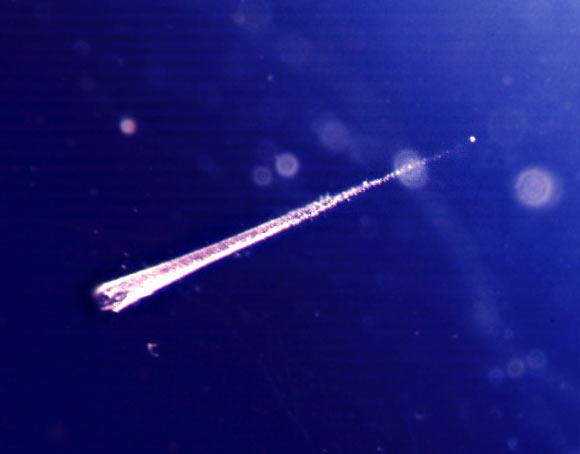According to a paper published in the journal Meteoritics & Planetary Science, Earth’s atmosphere is a better shield from meteoroids than scientists thought.

A 1.5-mm-long impact track of a meteoroid captured in aerogel exposed to space by the European Retrievable Carrier (EURECA) spacecraft. Image credit: NASA / ESA.
Meteoroids are small objects that have entered Earth’s atmosphere from space, reaching speeds up to 40 times faster than a bullet as they race toward the ground.
When a meteoroid enters the atmosphere, aerodynamic heating of the object produces a streak of light; this phenomenon is called a meteor. If that object withstands ablation from its passage through the atmosphere as a meteor and impacts with the ground, it is then called a meteorite.
NASA scientists estimate 44 tons of meteoroid matter lands on Earth every day, roughly the same weight as seven African elephants.
The friction generated between a falling meteoroid and the surrounding air particles can heat up the rock to the point of disintegration, but the new research suggests the air particles can also break up the meteoroid from the inside.
“There’s a big gradient between high-pressure air in front of the meteoroid and the vacuum of air behind it. If the air can move through the passages in the meteoroid, it can easily get inside and blow off pieces,” said lead author Professor Jay Melosh, a geophysicist at Purdue University.
Meteoroids are like piles of rubble, riddled with fractures and pores, but researchers had not previously considered how the percolation of air through the meteoroid could affect their breakup.
Professor Melosh and his colleague, Marshall Tabetah, uncovered the air percolation mechanism while simulating the 2013 Chelyabinsk event, where a 20-m (60-foot) wide object exploded 29.7 km (18.5 miles) above the Ural Mountains.
The explosion came as a surprise and brought in energy comparable to a small nuclear weapon. When it entered the planet’s atmosphere, it created a bright fire ball. Minutes later, a shock wave blasted out nearby windows, injuring hundreds of people.
The object weighed around 10,000 tons, but only about 2,000 tons of debris were recovered, which meant something happened in the upper atmosphere that caused it to disintegrate.
To solve the puzzle, the scientists used unique computer codes first developed by Los Alamos National Laboratory to model nuclear reactor explosions.
For the new research, the models were used to account for meteoroids’ loose conglomerate composition.
The simulations showed that the atmosphere buffets against the meteoroid’s side facing Earth, forming a dense pocket of air in front of the rock. On the flip side, the meteoroid’s wake creates a vacuum.
The pressurized air bubble ahead of the meteoroid is strongly attracted to the low-pressure environment developing behind the meteoroid, causing air particles to rapidly flow through the rock’s cracks and holes from the front to the back of the rock.
The high-pressure air moving through the meteoroid forces the fragments apart, causing the meteoroid to disintegrate in the upper atmosphere.
“While this mechanism may protect Earth’s inhabitants from small meteoroids, large ones likely won’t be bothered by it,” Professor Melosh said.
“Iron meteoroids are much smaller and denser, and even relatively small ones tend to reach the surface.”
_____
M.E. Tabetah & H.J. Melosh. Air penetration enhances fragmentation of entering meteoroids. Meteoritics & Planetary Science, published online December 11, 2017; doi: 10.1111/maps.13034







